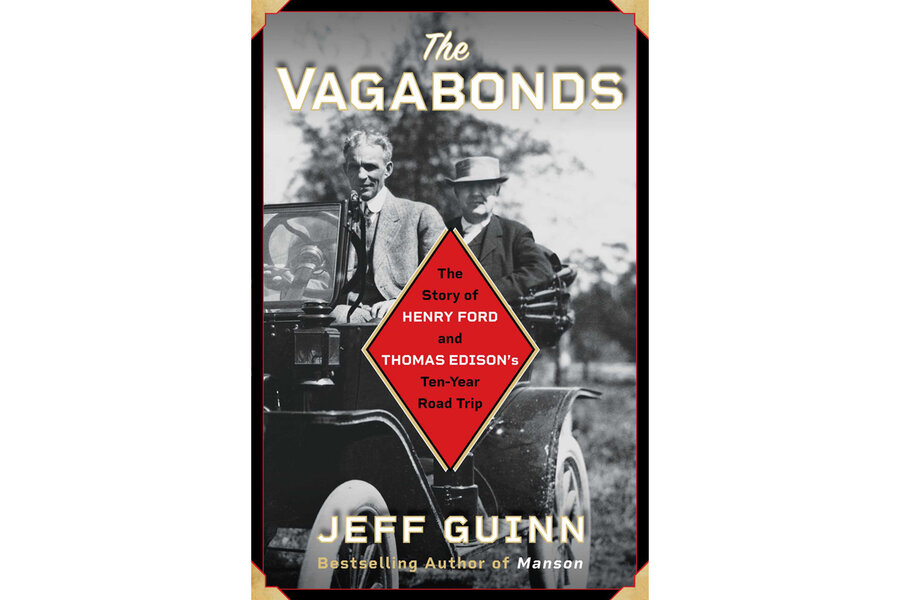Henry Ford and Thomas Edison steered Americans toward a love of road trips
Loading...
In fairy tales, peasants are often surprised to discover royalty quietly walking among them, the rulers of the realm connecting with the common folk.
Something similar happened in the early 20th century, when a handful of celebrity capitalists decided to sample the outdoors together on camping trips. Their journeys took them into small-town America, creating quite a stir among residents.
The group, which included automaker Henry Ford, inventor Thomas Edison, and tiremaker Harvey Firestone – along with naturalist John Burroughs in its earliest adventures – came to be known as “The Vagabonds.” Between 1914 and 1924, the trips of The Vagabonds became national news.
In “The Vagabonds: The Story of Henry Ford and Thomas Edison’s Ten-Year Road Trip,” author Jeff Guinn’s account of this curious tradition, he has a lot of fun documenting the double takes from unsuspecting souls who saw Ford and his friends on the road. The book begins in Paris, Michigan, on a rainy summer day in 1923, when a fleet of six grand vehicles rolled into town. “That guy in the back seat looks like Henry Ford!” one of the residents said. And so it was. Firestone was supposed to be in the party, but his car had gotten lost.
One of the pleasures of “The Vagabonds” is remembering a time when travelers – even those as wealthy as Firestone – did get lost, without the benefit of navigation systems to set them straight.
The premise of “The Vagabonds” has obvious appeal. Matthew Algeo struck a similar theme in “Harry Truman’s Excellent Adventure,” his charming 2009 book about how the 33rd president, newly freed from his White House duties, decided in 1953 to drive his own Chrysler from Missouri to New York and back, turning heads along the way.
But while Truman’s road trip seemed innocently impulsive, the camping vacations of The Vagabonds a generation earlier were, as Guinn tells it, more calculating. Ford and Edison were masters of self-promotion, and Ford, in particular, had much to gain from making vacation drives look attractive. When The Vagabonds set off, Ford often made sure that reporters were in tow.
To strike a note of populism, The Vagabonds gave the impression that they were roughing it, which they decidedly were not. At stops, Guinn writes, “they slept in large individual tents set up by staffers, enjoyed electric light from portable storage batteries, ate delicious meals prepared by a chef, and dressed each morning in freshly ironed clothes.”
But not even wealth could spare The Vagabonds from all the hardships of early 20th-century American roads, which were often, as Guinn points out, “roads only in the sense that they were dirt paths scored on each side by two deep ruts from wagon wheels and occasional car tires.”
Ford’s Model T had excelled as a consumer commodity, Guinn notes, in part because its light design allowed it “to skim over rock-rutted, pothole-clotted roads that routinely shook heavier cars to pieces.” Readers interested in the vagaries of motor travel during this period might also enjoy E.B. White’s 1936 essay “Farewell, My Lovely!” (also published as “Farewell to Model T”) and Eudora Welty’s recollections of road trips to Ohio and West Virginia in her 1984 memoir, “One Writer’s Beginnings.”
While White and Welty are lyrical in their evocation of automotive odysseys back then, Guinn doesn’t overlook the darker overtones of his story. Ford’s anti-Semitism – and to a lesser degree Edison’s – figures into “The Vagabonds,” since Ford’s bigotry informed campout conversations with his companions as well as with reporters. In one impromptu press conference, the auto magnate floated a crackpot theory that the Civil War had been caused by a Jewish cabal.
Burroughs, who traveled with The Vagabonds until his death in 1921, didn’t much care for cars, predicting that their drivers would, over time, “seek out even the most secluded nook or corner of the forest and befoul it with noise and smoke.”
Readers can judge for themselves how prophetic Burroughs turned out to be.
Editor's note: This article has been updated to include both titles of E.B. White's Model T essay.







